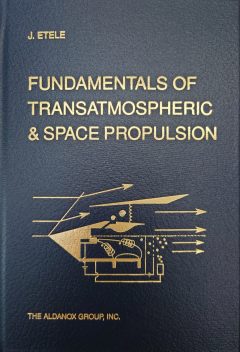This book is aimed at upper year and graduate students in engineering with an interest in the generation of thrust. Focusing on engines used to travel through the atmosphere in order to get to space, as well as those used in space, this textbook is an excellent reference for any aerospace enthusiast. Not only are propulsion concepts covered, but significant time is devoted to detailed discussions of orbital mechanics in order to understand the driving forces behind the requirements of getting to and operating in space.
This book can be used as a stand alone text for aerospace propulsion classes which cover:
- Rockets (single and multistage, solid [steady/unsteady pressure, grain shape], liquid [gas generator/expander/staged], two phase flow, flow divergence, Gibbs minimization technique, stability [centre of pressure], rocket based combined cycle engines [Fabri choke, thrust augmentation, afterburning])
- Ramjets and Scramjets (inlet compression, shock structure [Kantrowitz limit], oblique and rotating detonation waves)
- Arcjets (ionization, Maxwellian energy distributions, plasma behaviour, electric potential, heat flux potential, Elenbaas-Heller equation)
- Ion and Hall Thrusters (collisionless flow, Poisson’s equation, Child-Langmuir law, beam current, cyclotron frequency, collision frequency)
It can also serve as a reference for classes in:
- Orbital mechanics (topics covered include the two body problem, orbital elements and orbits [geostationary, sun synchronous, Molniya], reference frames [Heliocentric-ecliptic, ECI, spacecraft], J2 perturbations, orbit modification [plane change, Hohmann transfer], ballistic trajectories, Gauss variational equations)
- Fluid mechanics/Gas Dynamics (topics covered include control volume analysis [mass, momentum, energy], isentropic nozzle flow, Mach number and sound speed, partial pressure, planar [normal and oblique] and conical shocks, supersonic expansion [Prandtl Meyer function], Rayleigh and Hugoniot curves, diabatic flow, irrotational flow, homentropic flow, frozen flow)
- Thermodynamics/combustion (topics covered include the Brayton cycle, equilibrium combustion, Gibbs free energy, deflagrations/detonations, reaction rates, energy of combustion, thermal choking)
- Plasma physics (charge/current density, Ohmic heating, Hall current, Lorentz force, Larmor radius, Debye length, Hall parameter)
Containing over 700 equations, this textbook not only provides a comprehensive list of equations directly related to the design and analysis of propulsion systems, it never utters the phrase ‘it can be shown’. Instead, detailed derivations of every expression are provided, along with both exhaustive side notes to walk the reader through the details and over 240 illustrations to help the reader understand the variables involved.
Laid out in such a was as to allow a reader to go from start to finish, topics are presented as questions naturally occur. Any fundamentals required to analyze a given concept are examined as needed, presented in the same detail as all other subjects, and then applied back to the original concept. Alternatively, readers can simply browse the contents or the index to go directly to concepts of interest.
To order a copy, visit amazon.ca or email the publisher at “aldanoxgroup@gmail.com” with the subject line “propulsion textbook” along with your name and delivery address.
